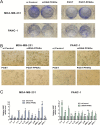PPARα regulates tumor cell proliferation and senescence via a novel target gene carnitine palmitoyltransferase 1C
- PMID: 28334197
- PMCID: PMC6248526
- DOI: 10.1093/carcin/bgx023
PPARα regulates tumor cell proliferation and senescence via a novel target gene carnitine palmitoyltransferase 1C
Abstract
Carnitine palmitoyltransferase 1C (CPT1C), an enzyme located in the outer mitochondria membrane, has a crucial role in fatty acid transport and oxidation. It is also involved in cell proliferation and is a potential driver for cancer cell senescence. However, its upstream regulatory mechanism is unknown. Peroxisome proliferator activated receptor α (PPARα) is a ligand-activated transcription factor that regulates lipid metabolism and tumor progression. The current study aimed to elucidate whether and how PPARα regulates CPT1C and then affects cancer cell proliferation and senescence. Here, for the first time we report that PPARα directly activated CPT1C transcription and CPT1C was a novel target gene of PPARα, as revealed by dual-luciferase reporter and chromatin immunoprecipitation (ChIP) assays. Moreover, regulation of CPT1C by PPARα was p53-independent. We further confirmed that depletion of PPARα resulted in low CPT1C expression and then inhibited proliferation and induced senescence of MDA-MB-231 and PANC-1 tumor cell lines in a CPT1C-dependent manner, while forced PPARα overexpression promoted cell proliferation and reversed cellular senescence. Taken together, these results indicate that CPT1C is a novel PPARα target gene that regulates cancer cell proliferation and senescence. The PPARα-CPT1C axis may be a new target for the intervention of cancer cellular proliferation and senescence.
© The Author 2017. Published by Oxford University Press. All rights reserved. For Permissions, please email: journals.permissions@oup.com.
Figures





References
-
- Sierra A.Y., et al. (2008) CPT1c is localized in endoplasmic reticulum of neurons and has carnitine palmitoyltransferase activity. J. Biol. Chem., 283, 6878–6885. - PubMed
-
- Bonnefont J.P., et al. (2004) Carnitine palmitoyltransferases 1 and 2: biochemical, molecular and medical aspects. Mol. Aspects Med., 25, 495–520. - PubMed
-
- Gao X.F., et al. (2009) Enhanced susceptibility of Cpt1c knockout mice to glucose intolerance induced by a high-fat diet involves elevated hepatic gluconeogenesis and decreased skeletal muscle glucose uptake. Diabetologia, 52, 912–920. - PubMed
Publication types
MeSH terms
Substances
LinkOut - more resources
Full Text Sources
Other Literature Sources
Research Materials
Miscellaneous

